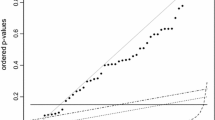Abstract
In a breakthrough paper, Benjamini and Hochberg (J Roy Stat Soc Ser B 57:289–300, 1995) proposed a new error measure for multiple testing, the FDR; and developed a distribution-free procedure to control it under independence among the test statistics. In this paper we argue by extensive simulation and theoretical considerations that the assumption of independence is not needed. Along the lines of (Ann Stat 32:1035–1061, 2004b), we moreover provide a more powerful method, that exploits an estimator of the number of false nulls among the tests. We propose a whole family of iterative estimators that prove robust under dependence and independence between the test statistics. These estimators can be used to improve also classical multiple testing procedures, and in general to estimate the weight of a known component in a mixture distribution. Innovations are illustrated by simulations.
Similar content being viewed by others
References
Abrahmsen P (1997) A review of gaussian random fields and correlation functions. Technical Report 917, Norwegian Computing Center, Norway
Benjamini Y, Hochberg Y (1995) Controlling the false discovery rate: A practical and powerful approach to multiple testing. J Roy Stat Soc (Ser B) 57:289–300
Benjamini Y, Yekutieli D (2001) The control of the false discovery rate in multiple testing under dependency. Ann Stat 29:1165–1188
Benjamini Y, Krieger AM, Yekutieli D (2004) Two staged linear step up FDR controlling procedures. Technical report Department of statistics, Tel Aviv University, Tel Aviv
Bickel DR (2004) On “strong control, conservative point estimation and simultaneous conservative consistency of false discovery rates”: does a large number of tests obviate confidence intervals of the FDR?. Technical report, Office of Biostatistics and Bioinformatics Medical College of Georgia, Georgia
Bovenhuis H, Spelman RJ (2000) Selective genotyping to detect quantitative trait loci for multiple traits in outbred populations. J Dairy Sci 83(1):173–180
Efron B, Tibshirani R, Storey JD, Tusher V (2001) Empirical Bayes analysis of a microarray experiment. J Am Stat Assoc 96:1151–1160
Ellis SP, Underwood MD, Arango V (2000) Mixed models and multiple comparisons in analysis of human neurochemical maps. Psychiat Res-Neuroim 9:111–119
Esary JD, Proschan F, Walkup DW (1967) Association of random variables, with applications. Ann Math Stat 38:1466–1474
Farcomeni A (2004) Multiple testing procedures under dependence, with applications. Ph.D. Thesis, Università degli studi di Roma “La Sapienza”; Dipartimento di Statistica Probabilità e Statistiche Applicate.
Genovese CR, Wasserman L (2002) Operating characteristics and extensions of the FDR procedure. J Roy Stat Soc (Ser B) 64:499–518
Genovese CR, Wasserman L (2004a) Exceedance control of the false discovery proportion. Technical report, Department of statistics, Carnegie Mellon University, Pittsburgh
Genovese CR, Wasserman L (2004b) A stochastic process approach to false discovery control. Ann Stat 32:1035–1061
Hochberg Y, Tamhane AC (1987) Multiple comparisons procedures. Wiley, New York
Ip EH (2001) Testing for local dependency in dichotomous and polytomous item response models. Psychometrika 66(1):109–132
Johnson ME (1987) Multivariate statistical simulation. Wiley, New York
van der Laan MJ, Dudoit S, Pollard KS (2003) Multiple testing Part III. Procedures for control of the generalized family-wise error rate and proportion of false positives. Technical Report 141, Division of Biostatistics, UC Berkeley
Merriam EP, Genovese CR, Colby CL (2003) Spatial updating in human parietal cortex. Neuron 39:361–373
Mosig MO, Lipkin E, Khutoreskaya G, Tchourzyna E, Soller M, Fridmann AA (2001) Whole genome scan for quantitative trait loci affecting milk protein percentage in Israeli-Holstein cattle, by means of selective milk DNA pooling in a daughter design, using an adjusted false discovery rate criterion. Genetics 157:1683–1698
Pollard KS, van der Laan MJ (2003) Resampling-based multiple testing: Asymptotic control of type I error and applications to gene expression data. Technical Report 121, Division of Biostatistics, UC Berkeley
Reiner A, Yekutieli D, Benjamini Y (2003) Identifying differentially expressed genes using false discovery rate controlling procedures. Bioinformatics 19:368–375
Sarkar SK (2002) Some results on false discovery rate in stepwise multiple testing procedures. Ann Stat 30:239–257
Simes RJ (1986) An improved Bonferroni procedure for multiple tests of significance. Biometrika 73:751–754
Smith R (2001) Environmental statistics. (2001) Environmental statistics. http://www.math.uio.no/˜glad/envnotes.ps
Storey JD (2002) A direct approach to false discovery rates. J Roy Stat Soc(Ser B) 64:479–498
Storey JD (2003) The positive false discovery rate: A Bayesian interpretation and the q-value. Ann Stat 31:2013–2035
Storey JD, Tibshirani R (2001) Estimating false discovery rates under dependence, with applications to DNA microarrays. Technical Report 2001-28, Department of Statistics, Stanford University, Stanford
Storey JD, Taylor JE, Siegmund D (2004) Strong control, conservative point estimation and simultaneous conservative consistency of false discovery rates: A unified approach. J Roy Stat Soc(Ser B) 66:187–205
Swanepoel JWH (1999) The limiting behavior of a modified maximal symmetric 2s−spacing with applications. Ann Stat 27:24–35
Woodroofe M, Sun J (1999) Testing uniformity versus a monotone density. Ann Stat 27:338–360
Worsley KJ, Marrett S, Neelin P, Vandal AC, Friston KJ, Evans AC (1996) A unified statistical approach for determining significant signals in images of cerebral activation. Hum Brain Mapp 4:58–73
Yekutieli D, Benjamini Y (1999) Resampling-based false discovery rate controlling multiple test procedures for correlated test statistics. J Stat Plann Inference 82:171–196
Author information
Authors and Affiliations
Corresponding author
Rights and permissions
About this article
Cite this article
Farcomeni, A. More Powerful Control of the False Discovery Rate Under Dependence. JISS 15, 43–73 (2006). https://doi.org/10.1007/s10260-006-0002-z
Received:
Published:
Issue Date:
DOI: https://doi.org/10.1007/s10260-006-0002-z




